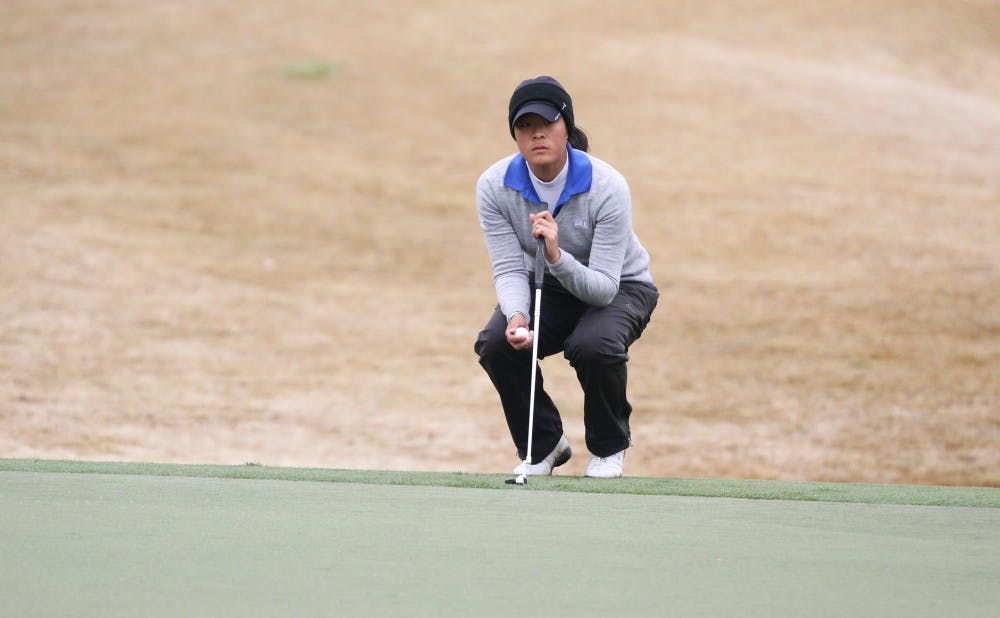It wasn’t the result she was hoping for, but rising junior Celine Boutier still gained a lot from missing the cut at this week’s U.S. Women’s Open.
The reigning National Player of the Year shot rounds of 77 and 76 to finish at 13-over-par with a total score of 153 after 36 holes. With the cut line at 10-over-par, Boutier was unable to limit the high scores on the difficult Pinehurst No. 2 course in the Village of Pinehurst, N.C. to stick around for the weekend. Two double bogeys in her first seven holes Friday largely derailed her chances to make the cut.
Despite the disappointing result, the Frenchwoman will be able to draw on her experience she gained in her first major on American soil as she continues preparing for a professional career under the tutelage of the Duke coaching staff.
“It's always a great way to learn, because I think it's probably one of the toughest courses I've ever played,” Boutier said. “So it's hard to handle the frustration first, because obviously I'm not going to shoot 5-under on these types of courses, but it's always great to play and I know what I have to work on in the future for the next U.S. Opens, hopefully.”
Boutier’s biggest teacher was the difficult, par-70 Donald Ross course that hosted the men’s U.S. Open last week. The sloping, turtleback greens that characterize the course and the way the USGA made it play this month gave players in both tournaments fits because good shots frequently ended up in bad spots.
The slim margin for error motivated Boutier to become even more detail-oriented about her strategy on the course and add more variety to her a game. For a player who has been so successful in her first two seasons as a Blue Devil, the tournament could prove very beneficial by giving her more incentive to strive for more, a scary thought for her collegiate competitors.
“I feel like my game was pretty good in general, but the course is just so hard that you--even if your shots are good, you're going to make a mistake because of the way you played it,” Boutier said. “So I feel like I have to learn more shots, especially the short game shots, because I feel like I don't really have that many shots in my bag, so I feel like if I learn to play different approaches, I'm going to be better.”
The statistics backed up Boutier’s Friday comments, as she hit 13 of 14 fairways in regulation, but was only able to hit 10 of the 18 greens in regulation because getting approach shots to stop on the greens was such an arduous task.
But after getting over the difficulty of the first few holes in each round, the NCAA Championship runner-up got much better in both rounds at grinding for pars, the mentality necessary to succeed in the U.S. Women’s Open and other majors. Boutier showed more toughness as the week wore on, playing her final 11 holes in just one-over-par and showing she could cope with tougher conditions.
“It's been really exciting and I had, I think, a little bit of stress on the first couple holes, but then I got—I think I got into the competition and the game,” Boutier said. “And I think it went pretty well. It's a tough course, so I'm not really happy with what I scored, but I'm pretty happy with how I handled it.”
Also making the week special was the proximity to her university, as head coach Dan Brooks, assistant coach Jeanne Cho and strength and conditioning coach Alex Merrill were all in attendance, along with multiple Duke fans.
Cho also helped Boutier find a local caddie, Darick McRae, who helped the ACC Player of the Year a great deal around Pinehurst’s puzzling greens. McRae is the grandson of Willie McRae, who has caddied at Pinehurst for 71 years.
The unique opportunity to play one of the most historic courses in the world as an amateur was not lost on Boutier, who found another positive in the perspective she gained after enduring such a strenuous test.
“Definitely I think [other courses] will seem a lot easier and if you play good on this type of course, you can play well anywhere.”
Get The Chronicle straight to your inbox
Sign up for our weekly newsletter. Cancel at any time.

